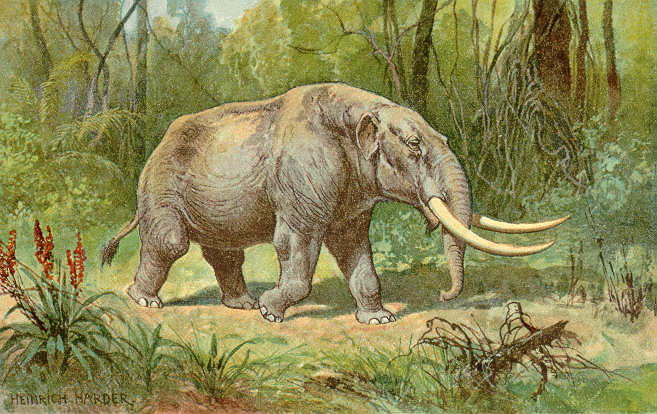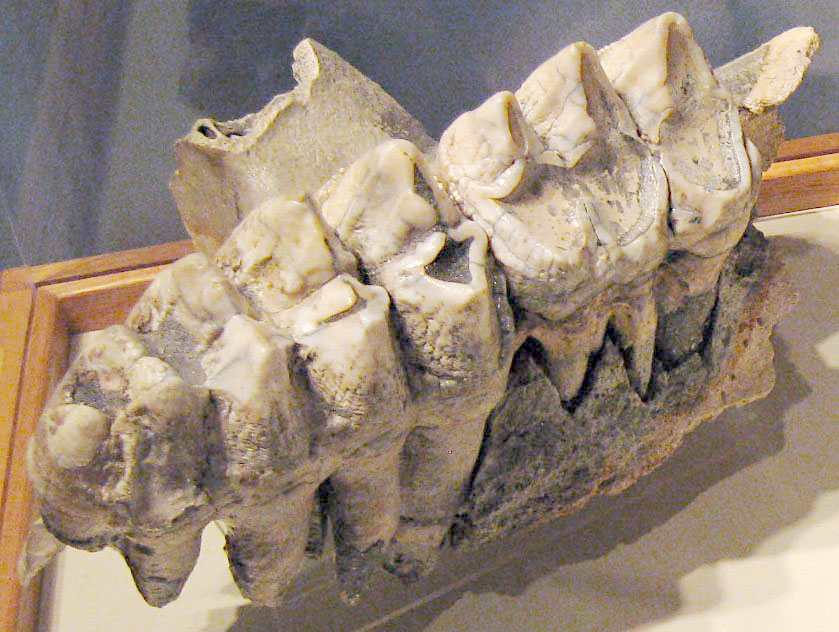
If you’ve ever visited a natural history museum, you might have seen a grand skeleton tower over you, with giant tusks gently sloping to the sky and a shape reminiscent of an elephant. Perhaps you thought immediately of a woolly mammoth, the most famous extinct elephant relative, popularized by Manny, the grumpy mammoth in Ice Age. However, there is another Pleistocene relative that you most certainly have also heard of: the mastodon.
Although similar, there are key differences between mammoths and mastodons.
| Feature | Mammoths | Mastodons |
|---|---|---|
| Tusk shape | Curved and pointed | Straight and tapered |
| Tusk size | Up to 16 feet long | Up to 8 feet long |
| Molar shape | Ridged and flat | Cone-shaped |
| Habitat | Grasslands and tundra | Forests and wooded areas |
| Geographic range | North America, Europe, Asia, and Africa | North and Central America |
| Cultural significance | Used by humans for food, tools, and art | Used by humans for food, tools, and art |
| Extinct | Yes | Yes |
| Extinction timeline | Approximately 10,000 years ago | Approximately 10,000 years ago |
Origin of mastodons and mammoth
First of all, mastodons came into existence much earlier, about 27 to 30 million years ago. Mammoths are “young” by comparison, having emerged a mere 5.1 million years ago in Africa. There were multiple mammoth species, but the famous woolly mammoth is the baby of the bunch, emerging only 250,000-400,000 years ago.
Mammoths could be found across Eurasia and North America. Mastodons were not so widespread and called North and Central America their home (still a considerable area considering that they could be found from Alaska to central Mexico).
Although mammoths preferred cooler temperatures and mastodons preferred warmer temperatures, they both shared a habitat in Beringia, the land bridge between Eastern Siberia and Alaska that wasn’t covered by the ocean during the Ice Ages.
They lived there at the same time during the early to mid-Pleistocene, but the mastodons left because it got too chilly for them. Mammoths still survived in Beringia until 13,000 years ago, and a subset that evolved to be small (about the size of a large horse) survived on arctic islands until as recently as 4,000 years ago.
To put it into perspective, the Great Pyramid was being constructed around the same time mini mammoths were ruling an arctic island — as crazy as it sounds, mammoths and the pyramids were around at the same time (for a brief period).
Lifestyle differences
Mammoths and mastodons led different lifestyles and their appearance reflects these differences.
Mastodons lived mainly in forests. Accordingly, their teeth have cone-shaped cusps, perfect for crushing leaves and twigs. Sometimes, the plants that animals eat are also preserved alongside their fossil remains. Researchers who have quantified mastodon gut contents have found a lot of twigs from coniferous trees, while another study found mostly low, herbaceous vegetation in their guts. Therefore, they likely browsed and grazed, changing their preference based on the season and where they were.

Mastodons were named for the shape of their teeth. The French taxonomist Georges Cuvier apparently thought that the teeth looked like breasts so he derived their name from masto (“breast” in Greek) and odon (“teeth” in Greek).

On the other hand, mammoths are much more closely related to modern-day elephants than mastodons, and lived a similar lifestyle. They used to live on large, open plains and had flat teeth with ridges for grazing. Elephants also have similarly shaped teeth.
Mammoths mostly ate flowering plants because they contain more protein and are easier to digest than grasses. Some species of mammoth also munched on other types of vegetarian delights, such as cactus leaves, trees, and shrubs.
A baby mammoth preserved in the permafrost also brought to light that baby mammoths ate their parents’ dung because it is easier to chew, like elephants living today do.

Physical differences between mammoths and mastodons
Though mammoths and mastodons were both large, hairy, elephant-like creatures, they did have some differences other than their tooth shape. Mastodons were a bit shorter and stockier. Since mammoths tended to live in colder climates, they had fatty humps where they stored extra nutrients necessary to survive the long, frigid winters and warmer fur coats. Mammoth tusks curved more while mastodon tusks were straighter and shorter.
Mammoths had a distinctive bump at the top of their skulls while mastodons had flatter heads and sloping back. There were multiple species of mammoth (not just the woolly mammoth!) and mastodon that varied slightly in different aspects of their appearance — skeletal and dental differences, for example.

Extinction
Although mastodons evolved earlier than mammoths, both went extinct at a similar time, about 10,000 years ago. However, their remains have been preserved in various ways, including fossils, tusks, and even frozen carcasses.
One of the most well-known examples of a preserved mammoth is the Siberian mammoth named “Lyuba,” which was discovered in 2007. This baby mammoth, who died approximately 40,000 years ago, was so well-preserved that her skin, hair, and even some of her internal organs were intact.
In recent years, advances in DNA analysis have allowed scientists to study the genomes of mammoths and mastodons, providing new insights into their biology and evolution. Some researchers are even working on “de-extinction” projects, which aim to bring these species back to life using genetic engineering.
There is some disagreement between experts about what exactly brought about the demise of these gentle giants — but there are two prevailing theories.
The first is that they were unable to survive due to increasing temperatures after the end of the last ice age 12,000 years ago. Glaciers retreated and sea levels rose, with the warmer temperature causing the environment to change. Forests grew up where open woodland and grasslands had been. The arctic tundra and steppe were dominated by flowering plants, but when the climate became wetter and warmer, they were replaced by grasses, which were not so nutritious or easy to digest for mammoths.
However, some researchers argue that similar warming periods had occurred over the past several million years within the ice age without such disastrous consequences. Therefore, the second theory is that someone new on the scene played a large role in their demise, more specifically, humans.
There is evidence that Homo erectus ate mammoth meat 1.8 million years ago, but this could be a result of scavenging as opposed to active hunting.
Some sites created in the past 50,000 years in Eastern Europe and Britain present further evidence that humans hunted mammoths: dwellings made from mammoth bones and mammoth remains. The spread of more skilled human hunters around Eurasia and North America coincided with the disappearance of mammoths and mastodons. However, these creatures lived across such an enormous area, including remote areas of Siberia, that it is uncertain if humans with primitive weapons would have been able to decimate them.

http://cloudinary.com.
It is more likely that the combination of a changing climate and human hunters led these giants to their end. The shrinking of suitable areas to live in likely caused many to die out, rendering the remaining populations more vulnerable.
All in all, mammoths and mastodons lived different lifestyles but still looked quite similar, except for some special adaptations for their diet and climate. They also share similar causes for their demise. Now, on your next visit to the natural history museum, see if you can guess if that big, tusked skeleton is a mammoth or mastodon.



